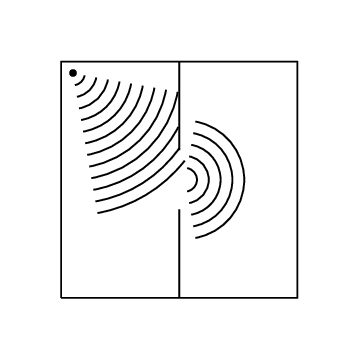6.4 Diffraction
|
Previous
6.3 Huygens' principle
|
Next
6.5 Diffraction through a single slit
|
6.4 Diffraction (ESBNH)
One of the most interesting, and also very useful, properties of waves is diffraction.
- Diffraction
-
Diffraction is the ability of a wave to spread out in wavefronts as the wave passes through a small aperture or around a sharp edge.
For example, if two rooms are connected by an open doorway and a sound is produced in a remote corner of one of them, a person in the other room will hear the sound as if it originated at the doorway.

As far as the second room is concerned, the vibrating air in the doorway is the source of the sound.
This means that when waves move through small holes they appear to bend around the sides because there are not enough points on the wavefront to form another straight wavefront. This is bending round the sides we call diffraction.
Diffraction effects are more clear for water waves with longer wavelengths. Diffraction can be demonstrated by placing small barriers and obstacles in a ripple tank and observing the path of the water waves as they encounter the obstacles. The waves are seen to pass around the barrier into the regions behind it; subsequently the water behind the barrier is disturbed. The amount of diffraction (the sharpness of the bending) increases with increasing wavelength and decreases with decreasing wavelength. In fact, when the wavelength of the waves are smaller than the obstacle, no noticeable diffraction occurs.
This experiment demonstrates diffraction using water waves in a ripple tank. You can also demonstrate diffraction using a single slit and a light source with coloured filters.
Diffraction
Water waves in a ripple tank can be used to demonstrate diffraction and interference.
-
Turn on the wave generator so that it produces waves with a high frequency (short wavelength).
-
Place a few obstacles, one at a time, (e.g. a brick or a ruler) in the ripple tank. What happens to the wavefronts as they propagate near/past the obstacles? Draw your observations.
-
How does the diffraction change when you change the size of the object?
-
-
Now turn down the frequency of the wave generator so that it produces waves with longer wavelengths.
-
Place the same obstacles in the ripple tank (one at a time). What happens to the wavefronts as they propagate near/past the obstacles? Draw your observations.
-
How does the diffraction change from the higher frequency case?
-
-
Remove all obstacles from the ripple tank and insert a second wave generator. Turn on both generators so that they start at the same time and have the same frequency.
-
What do you notice when the two sets of wavefronts meet each other?
-
Can you identify regions of constructive and destructive interference?
-
-
Now turn on the generators so that they are out of phase (i.e. start them so that they do not make waves at exactly the same time).
-
What do you notice when the two sets of wavefronts meet each other?
-
Can you identify regions of constructive and destructive interference?
-
|
Previous
6.3 Huygens' principle
|
Table of Contents |
Next
6.5 Diffraction through a single slit
|
